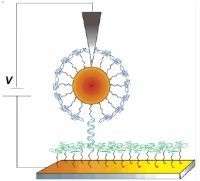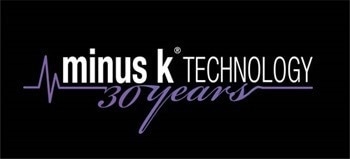It has been suggested that molecular electronics can be based on DNA. Since DNA can recognize other molecules, other DNA strands and as it binds with similar DNA strands innovatively scientists have suggested using DNA as an electronic circuit without the need to build in any other circuitry.
Dr. Sidney R. Cohen in collaboration with Dr. Ron Naaman and Dr. Claude Nogues of the Weizmann Institute of Science, Scanned Probe Microscopy Unit, in Rehovot, Israel, aided by the enabling technologies of ultra-high-resolution microscopy and negative-stiffness vibration isolation have conducted research that sheds new light on the electrical transport properties of DNA, focusing on the capacity of single molecules of DNA to transport current along individual strands.
The Weizmann Institute's Scanned Probe Microscopy Unit
The Weizmann Institute's Scanned Probe Microscopy Unit offers research and imaging into the nano-scale electrical and mechanical properties of materials and biological applications, such as with DNA.
The lab has facilities for sample preparation and testing involving ultra-high resolution microscopies and localized surface probing using scanned probe microscopies. The unit contains three separate scanning tunneling/scanning force microscopes that help determine the surface topography, electrical and mechanical properties at resolutions ranging from tens of microns down to atomic scale. It also includes liquid cells, heated and cooled stages, and a gas inlet allow working in different media and under controlled temperature and humidity.
DNA Measurement Challenges
DNA nanotechnology makes use of the unique molecular-recognition properties of DNA to create self-assembling branched DNA complexes with useful properties.
In order to determine the electronic properties of DNA, Dr. Cohen and his staff connected a volt electrode to the end of a DNA molecule, which is only a few nanometers in length, using an AFM (atomic force microscope). To facilitate this bio-molecular connection, the lab attached a bio-link, a gold electrode, to a single strand of DNA, and then attached a very small gold ball (10 to 20 nm in size) to a complimentary DNA strand, after which these two strands were hybridized.
In case the strands are complementary, the matching cousin on the other strand will form a double-strand. Single DNA strands do not conduct electricity, however the double strand may conduct for certain configurations.
DNA molecules are destroyed easily. It was a challenge to hook up these gold connectors and balls at the nano level without tearing them off or burn them. With the help of an AFM, with the DNA double-strand displayed on a flat surface, the researchers were able to locate the gold ball, put the AFM tip on top of the ball, flow a current through the double-strand and view the current voltage characteristics.

Figure 1. Schematic of the measuring system - DNA oligomer is attached to a gold electrode below, and hybridizes with a DNA attached to a gold nanoparticle which then forms the upper electrode for the double-stranded DNA. Current is measured by applying a bias between upper and lower electrodes with placement controlled by the AFM tip - Weizmann Institute
Electron Transport Properties of DNA
Dr Cohen explained that there are two possibilities while talking about the flow of electrons through a DNA molecule. These are:
- Tunneling process: In this process, the electron shoots through the molecule without caring too much about the internal structure of the molecule.
- Hopping Process: In this process, the electron actually resides for small periods of time in certain positions along the molecule. In this case the electron will be affected by temperature.
Cohen also discovered that changes in the sequence and the composition of a strand's amino acids can also affect the progress of electron transport through the strand. Also amino acids that are very electron rich have better electron conductivity than those amino acids which have fewer available electrons. The characteristics of electron conductivity in DNA also have implications in molecular electronics.
Vibration Isolation Critical to DNA Research
The Weizmann Institute is one of the few research groups in the world that has actually managed to measure the electrical transport properties of a single molecule of DNA. Vibration isolation is one of the challenges that presents itself in nanoscale research. Every laboratory that measures and images at the nano-level deals with problems of site vibration, which compromises to a greater or lesser degree the imaging quality and data sets which are acquired through ultra-high-resolution microscopy.
The Weizmann’s Institute used negative-stiffness vibration isolation systems by Minus-K technologies to provide the ultra-stable environment required by AFMs to execute this research.
Negative-stiffness mechanism (NSM) isolators can customize resonant frequencies both horizontally and vertically. They employ a completely mechanical concept in low-frequency vibration isolation. A stiff spring provides vertical-motion isolation that supports a weight load, combined with a NSM. The net vertical stiffness is made very low without affecting the static load-supporting capability of the spring.
Horizontal-motion isolation is provided by beam-columns connected in series. The horizontal stiffness of the beam-columns is reduced by the "beam-column" effect.
A beam-column acts as a spring combined with a NSM. The result is a compact passive isolator that can isolate very low vertical and horizontal natural frequencies and very high internal structural frequencies.
Transmissibility with negative-stiffness better than air systems as they may make vibration isolation problems worse as they have a resonant frequency that can match that of floor vibrations. Transmissibility measures vibrations that transmit through the isolator relative to the input vibrations. The NSM isolators, when adjusted to 0.5Hz, achieve 93 % isolation efficiency at 2 Hz; 99 % at 5Hz; and 99.7 % at 10Hz. NSM transmissibility is also better than active systems.
Active systems can be influenced negatively by problems of electronic dysfunction and power modulations as they run on electricity. They also have a restricted dynamic range, which is easy to exceed causing the isolator to go into positive feedback and generate noise underneath the equipment. Although active isolation systems have basically no resonance, their transmissibility does not roll off as fast as negative-stiffness isolators.
Leading the Way
The Weizmann Institute conducts original research into a number of diverse areas, including mechanical properties of materials and biological applications, such as with DNA. The techniques for obtaining successful results from its research are a continuing process of improving and refining its protocols, procedures, equipment and systems. Dr. Cohen, together with Doctor Nogues and Doctor Naaman, continue to pioneer and lead the way to a better understanding of the electron transport properties of DNA molecules.
About Minus K Technology
Minus K® Technology, Inc. was founded in 1993 to develop, manufacture and market state-of-the-art vibration isolation products based on patented negative-stiffness technology. Minus K® is based in the Los Angeles area.
The Minus K® products, formerly sold under the trade name Nano- K®, represent an important enabling technology. By reducing building and floor vibrations to unprecedented levels these systems enable vibration sensitive instruments and equipment to perform at unprecedented levels. They are used in a broad spectrum of applications including nanotechnology, biological sciences, semiconductors, materials research, zero-g simulation of spacecraft, and high-end audio. Minus K® is an OEM supplier to leading manufactures of scanning probe microscopes, micro-hardness testers and other vibration-sensitive instruments and equipment. Minus K® customers include private companies and more than 200 leading universities and government laboratories in 41 countries.
Dr. David L. Platus is President and Founder and is the principal inventor of the technology. He earned a B.S. and a Ph.D. in Engineering from UCLA, and a diploma from the Oak Ridge School of (Nuclear) Reactor Technology. Prior to founding Minus K® Technology he worked in the nuclear, aerospace and defense industries conducting and directing analysis and design projects in structural-mechanical systems. He became an independent consultant in 1988. Dr. Platus holds over 20 patents related to shock and vibration isolation.

This information has been sourced, reviewed and adapted from materials provided by Minus K Technology.
For more information on this source, please visit Minus K Technology.